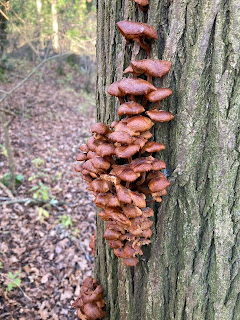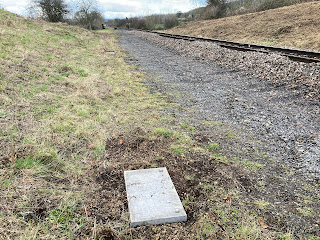Wednesday 19 January
Two team members together with seven from C&M (mainly the Broadway team) working today with one objective – moving the pile of broken paving slabs from the old garden centre site at Toddington to Working Lane. At Working Lane most of these are now part of the base for the extended hardstanding area. The few complete or almost complete slabs were put by for other uses. With four vehicles in use, one of which was the Citroen tipper, the task took much less time than we anticipated, completion was early in the afternoon.
 |
| The pile of slabs almost gone from the former garden centre site at Toddington. |
 |
| Where they have gone to - the hard standing flat area at the foot of the haul road from Working Lane to opposite Royal Oak, up side. |
Hence some time to progress the Milepost project. The two of us fabricated the galvanised metal cap for milepost 12 on the up platform at Winchcombe. This was an in-situ job; bending the cap to fit the head snugly on site is not as easy as in the workshop. There are plenty of other posts which need caps fitting; so probably we will take the heads off and fit the caps in the workshop.
 |
| The galvanised cap fitted to mp 12 will arrest the rot of the wooden head. A lick of paint will make this most presentable - it is the only one on a currently public accessible platform. |
Thursday 20 January
The other five members of the team attended on the usual Thursday work day. Our master brick layer and the wizard mixer operative set to work on culvert 24B haul road exit at Working Lane. By the end of the day this was complete apart from the coping course.
 |
| 24B haul road exit headwall, just coping course to go. Picture by Polly, who says his camera is not fitted with a spirit level, it is the camera that is leaning; not the headwall! |
The other three members continued with the vegetation clearance and internal visual inspections of culverts and cross drains. First today were 27A and 27B, at Gretton. This included checking how the new up side high mileage toe drain was performing. We installed this earlier in the year; when the neighbouring land was very boggy. Good to report it is performing well; the ground at the foot of the embankment and by the neighbours pond is now just damp.
 |
| Up side high mileage 27B toe drain pipes installed earlier this year working well, water running from both. One comes under the fence from the adjoining land. |
Next along is culvert 27C, which is actually a 12inch diameter pipe. Immediately it was obvious that this was restricted, but not having the drainage rods with them the inspection was abandoned.
 |
| 27C inlet chamber down side; water should be flowing out of the toe drain pipe here, not into it! |
Working south the next culvert is 28A which is also a pipe, but a very long one which runs alongside the course of the old road to Stanley Pontlarge. When the GWR built the line in the 1900s; the road was diverted under what is now bridge 28. This was another case of deferring the full inspection; this time as the vital implement not to hand was the long handled grab to remove silt from the chamber at the end of the outlet.
The final two structures inspected were culverts 30A and 30B at Middle Stanley. 30A runs under bridge 30, or Tunnel Bridge. The main issue with both of these culverts is the steepness of the embankment sides; particularly near the bridge. Our Health & Safety rep has made a note that cutting some steps into the embankment here is required.
Thursday 27 January
The full team of seven in today – so a split into three sub teams. The first took a permaquip trolley up to Broadway to collect concrete drain lids from platform 2. Using the trolley on the loop line to bring the lids to the Transit truck at the top of the access from the car park was the easiest and safest method; especially with platform 1 obstructed by scaffolding for the roof extension. These recovered lids then headed to Dixton cutting.
Sub team two first headed to Stanley Pontlarge equipped with the long handled grab to remove the silt from outlet chamber of culvert 28A. The silt is almost entirely sand, washed down from the road above the line on the down side. After silt removal, which dropped the water in the chamber by around 4 inches, they completed the visual inspection of 28A.
 |
| The deep chamber on 28A outlet; even with the long handled grab it is a two stage lift to get the silt onto the parked truck. |
Then back to Working Lane to meet with the other teams for lunch; and to inspect the labours of the construction team. The famous ‘construction two’ had been very busy during the morning; the haul road outlet of 24B was now complete with coping course and kerb stones by the side of the haul road. With just some infill required on the outlet and addition of marker posts both sides of the haul road, that is 24B up side complete. Hopefully we will be able to make a start on the down side later in the year.
 |
| 24B haul road exit; side view. Back filling required to finish - but that will hide the size 10 boot imprints on the surplus mortar. |
 |
| 24B up side; the new part under the haul road in the foreground and the 2017 built exit headwall under the railway in the background. |
After lunch the construction duo cleared up the site at 24B and moved some materials to be ready for the next construction, 24C up side haul road exit. Hopefully the lack of rain will continue in the next couple of weeks whilst we excavate this one.
The other two teams combined, first stop with the drain rods was 27C. Fortunately the obstruction was just a few rod lengths from the down side inlet, and it moved easily. Water started flowing quicker and the level upstream dropped a couple of inches in a few minutes. This enabled the visual inspection to be complete; we could now see the top of bore pipe in the inlet chamber.
 |
| 27C inlet chamber (down side); the bore pipe that runs under the railway is just visible below the cess inlet plastic pipe (centre). Compare the water level with the photo taken a week ago. |
Next for visual inspection was 31A; near JJ Farms bridge 31. The down side chamber here is one rebuilt in the early GWSR days using concrete filled sandbags. Here they have lasted reasonably well, but will at some point in the not too distant future will need replacing with a proper brick structure.
 |
| Cement filled sandbags are OK for temporary repairs; this is low mileage side of 31A inlet. Not helped by an ash tree growing by the toe drain. |
The teams were now in Dixton cutting; so the lids on the upside concrete cess drain which had been damaged during the track relaying operation before Christmas were replaced with the lids collected from Broadway.
Finally it was visual inspections and clearance of three more culverts, 32A, 33A and 33B. 32A is probably the most visually specular culvert on the line, it is the ‘fume’ that takes the Tirle Brook under the line in Dixton Cutting.
 |
| And here is the view into the bore; looking upstream the 'flume' on the down side just visible. Photo by Jonathan. |
After periods of heavy rain the flow on the down side inlet is white water. On the up side the railway land extends for a considerable distance, through a wooded ravine; on the Isle of Man this would be called a glen. With quite steep sides and several fallen trees, this outlet needs regular checking for obstructions. None found today, nor did we find any fairies or pixies, not even deer. What we did find was some interesting tree fungus, so far none of our experts have identified it.
 |
| Interesting tree fungi in the Tirle Brook glen. Anyone able to identify it? |
A busy and varied day, made pleasant with some afternoon sunshine. Also noteable as the first time this year it was still daylight when we left Winchcombe Yard to head home.













